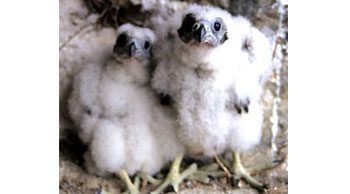Bird Vocabulary: Verging on the Nidicolous
By Hugh Powell July 15, 2008
Like any self-respecting science, ornithology contains some absolute humdingers of vocabulary words. Take the ridiculous “nidicolous”: Isn’t there a better way of saying that chicks remain in the nest after hatching? (These Orange-breasted Falcon chicks – faintly ridiculous themselves – are just one example of, er, nidicolousness.)
Here at the Lab, we try to shield you from birdspeak at its most arcane. But as anyone who has had to distinguish a greater primary covert from an outer rectrix knows, some degree of vocabulary is unavoidable. Recently a few people have suggested we provide a glossary of terms that we use commonly but that might present an obstacle to some readers.
Great idea! (Now, in addition to the Bird ID tool we’re working on, and the Song ID tool that many of you have nominated in comments, it seems we may need a Word ID tool.) I’m sure you can guess the next part: What words do you run across that you wish we’d explain?
What do commonly bandied words like “habitat,” “juvenile,” or even “species” really mean? What’s a “pileum,” a “cere,” a “gonydial angle”? What special attributes does a bird need to be considered a “cosmopolitan species” or an “indicator”? Does anyone have any other suggestions?

All About Birds
is a free resource
Available for everyone,
funded by donors like you
American Kestrel by Blair Dudeck / Macaulay Library
